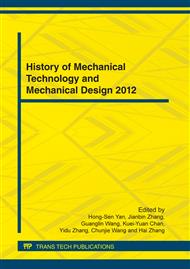[1]
S. Lee and C. Yi, Statistical tolerance and clearance analysis for assembly. Proceedings of IEEE/RSJ International Conference on Intelligent Robots and Systems. (1996) IROS 96: 688-695.
DOI: 10.1109/iros.1996.571038
Google Scholar
[2]
S. Jin, C. Zheng, K. Yu and X. Lai, Tolerance design optimization on cost – quality trade-off using the Shapley value method. J. of Manufac. Sys., 29(4) (2011) 142-150.
DOI: 10.1016/j.jmsy.2011.01.003
Google Scholar
[3]
K. Sivakumar, C. Balamurugan and S. Ramabalan, Simultaneous optimal selection of design and manufacturing tolerances with alternative manufacturing process selection. Comput. Aided Des. 43(2) 207-218. Elsevier Ltd. doi: 10. 1016/j. cad. 2010. 10. 001.
DOI: 10.1016/j.cad.2010.10.001
Google Scholar
[4]
M. Mansuy, M. Giordano and P. Hernandez, A new calculation method for the worst case tolerance analysis and synthesis in stack-type assemblies. Comput. Aided Des. 43(9) (2011) 1118-11125.
DOI: 10.1016/j.cad.2011.04.010
Google Scholar
[5]
T. Y. Lin and C. C. Cheng, A novel opto-mechanical tolerance analysis method for precision lens systems. Precis. Eng. 35(3) (2011) 447-454.
DOI: 10.1016/j.precisioneng.2011.02.001
Google Scholar
[6]
E. Pearce, A. Parkinson and K. Chase, Tolerance analysis and design of nesting forces for exactly constrained mechanical assemblies. Res. in Eng. Des. 15(2004) 182-191.
DOI: 10.1007/s00163-004-0053-9
Google Scholar
[7]
H. P. Peng, X. Q. Jiang and X. J. Liu, Concurrent optimal allocation of design and process tolerances for mechanical assemblies with interrelated dimension chains. Int. J. of Prod. Res. 46 (24) (2008) 6963–6979.
DOI: 10.1080/00207540701427037
Google Scholar
[8]
D. I. D. You, Tolerance analysis: Preparing your model for the real world. Parametric Technology Corporation (PTC) (2009). www. creo. uk. com/articles_tolerance_analysis. html.
Google Scholar
[9]
J. J. Shah, G. Ameta, Z. Shen and J. K. Davidson, Navigating the tolerance analysis maze. Comput. Aided Des. & Appl. 4(5) (2007) 705–718. http: /cadanda. com/CAD_4_5_13. PDF.
DOI: 10.1080/16864360.2007.10738504
Google Scholar
[10]
L. Guowei, Z. Weimin and C. Can, Tolerance analysis considering the impact of working conditions on product performance. 2nd International Conference on Industrial Mechatronics and Automation (ICIMA 2010).
DOI: 10.1109/icindma.2010.5538102
Google Scholar
[11]
A. Asha, S. M. Kannan and V. Jayabalan, Optimization of clearance variation in selective assembly for components with multiple characteristics, Int. J. of Adv. Manufac. Technol. (2008) 1026-1044.
DOI: 10.1007/s00170-007-1136-3
Google Scholar
[12]
K. Kappaganthu and C. Nataraj, Nonlinear modeling and analysis of a rolling element bearing with a clearance. Commun. in Nonlinear Sci. and Num. Sim. 16(10) (2011) 4134-4145.
DOI: 10.1016/j.cnsns.2011.02.001
Google Scholar
[13]
H. Marjamaki and J. Makinen, Modeling a telescopic boom – the 3D case: Part II. Comput. and Struct. 84 (29-30) (2006) 2001–(2015).
Google Scholar
[14]
G. Kelly, S. Hallstro, Bearing strength of carbon fiber/epoxy laminates: effects of bolt-hole clearance. Composites Part B: Eng. 35(4) (2004) 331–343.
DOI: 10.1016/j.compositesb.2003.11.001
Google Scholar
[15]
L. Tong, Bearing failure of composite bolted joints with non-uniform bolt-to-washer clearance. Composites Part A: Appl. Sci. and Manufac. 31(6) (2000) 609-615.
DOI: 10.1016/s1359-835x(99)00090-1
Google Scholar
[16]
B. G. Kiral, Effect of the clearance and interference-fit on failure of the pin-loaded composites. Materials and Des. 31(1) (2010) 85-93.
DOI: 10.1016/j.matdes.2009.07.009
Google Scholar


